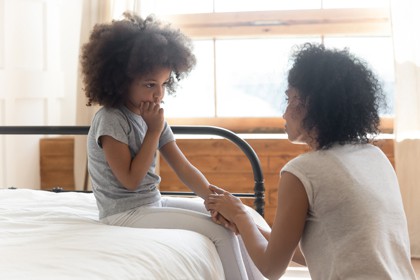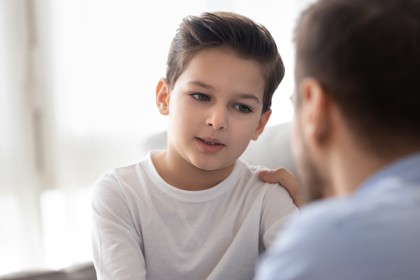Of all the hard conversations you’ll have with your children, talking about bullying can be among the toughest. But at some point in their lives, it’s likely your children will have to deal with bullies.
October is National Bullying Prevention Month in America. While it’s always a good time to talk with your children about bullying, now’s a good time to review what to do when your child encounters bullies.
Signs of Bullying 
Bullying can be defined as aggressive behavior that is unwanted and is repeated over time. And it usually involves some kind of power imbalance, even if it’s only perceived power.
Bullying may include physical or verbal attacks, purposefully excluding someone from a group, threatening someone, or spreading rumors.[1]
Common signs a child is being bullied can include:
- Unexplainable injuries
- Your child expressing low-self esteem or helplessness
- Declining grades or quality of school work
- Your child no longer wants to attend school or social situations
- Lost or destroyed clothing, toys, books, electronics
- Frequent headaches or stomach aches, or faking illness
- Changes in eating habits
- Self-destructive behaviors like running away, hurting themselves, or talking about suicide[2]
When you see signs of bullying, schoolyard bullies are probably the first thing that comes to mind. It can be stressful to parents or caretakers of children when the bullying happens at school because you can’t be there to protect them. You can read more about in-school bullying here, including ways teachers can help in the classroom.
Signs of Cyberbullying
As children spend more time online, they’re more likely to encounter cyberbullies. Nearly three in five teens say they’ve been cyberbullied.[4] Online bullying, or cyberbullying, has many of the same characteristics as other types of bullying in schools, but it takes place over the Internet, including during gaming, through social media posts, and direct messages.[3]
Keep an eye out for these signs of cyberbullying in your child:
- Suddenly and unexpectedly stopping using devices
- Becoming uneasy about going to school
- Attempting to avoid unstructured time
- Requesting not to work in groups or with a specific student
- Avoiding discussions about what they are doing online[5]
Some cyber safety rules, such as not giving out personal information online, can help create a safer environment for children online. Remind your children not to give out photos, descriptions, phone numbers, or addresses to people online, and especially to keep their passwords safe. A good rule of thumb is: “Don’t do or say anything online that you wouldn’t do or say in person.”[11]
How to Talk to Your Child About Bullying
If your child’s being bullied, they may not want to tell you, or even want to talk about it. They’re not alone—only 20% of school bullying incidents are reported.[6]
Why? Being bullied may make your child feel helpless or weak. They could be afraid of retaliation. They might also feel humiliated and afraid of being judged, or they may fear rejection from their family, friends, and peers. There are many reasons children don’t speak up about bullying.[2]
Many children don’t report bullying because they don’t want to be seen as a tattletale. It’s important to let them know that talking about bullying is not tattling.
One of the most important things you can do is listen to what your child has to say. Your child’s experience can be painful to hear, but do try to listen without interrupting. Reacting strongly to what they’re saying may make your child think they’re upsetting you.[8]
As you listen, avoid reacting in a way that would make them feel they’re at fault. Don’t blame your child or try to see what they’re doing to “bring it on themselves.”[8]
There are some other ways you can help your child be comfortable talking about their situation with you.
During the conversation, make sure your child knows:
- It’s not their fault, and they’re not to blame
- They’re not alone, you are here to help
- It’s the adult’s responsibility to make it stop
- They deserve to be treated with respect and deserve to feel safe
- No one deserves to be bullied[7]
The biggest help is to make them feel supported and empowered.
What to Do if Your Child is Being Bullied
It’s natural for a parent or caregiver to want to tell their child to ignore or stand up to a bully, or even to take matters into your own hands. But those tactics aren’t usually effective. Here’s what to do instead.
 Talk to others who can help. Speaking with the school or other officials is the best place to start. They can act as mediators between parents, while also taking action to help stop bullying.
Talk to others who can help. Speaking with the school or other officials is the best place to start. They can act as mediators between parents, while also taking action to help stop bullying.
You can ask your child what can be done to make them feel safe (while trying to avoid changes to routine). Educators might take such simple steps as changing class seating or bus seating plans. Note that if big changes are needed, the child who is being bullied should not be forced to change or make accommodations.
Open communication between schools or organizations and parents is key to helping stop bullying. Just remember that often laws don’t allow schools to discuss discipline or other consequences given to other children.[9]
Keep a written record. You’ll want to have as much information about the situation as possible, including how long it’s been going on, who’s involved, and what steps have been taken.[7]
Write down the times when your child is bullied. This written record can be helpful for talking to schools or other people who need to be involved. It can be critical to document what happens.[10] Your records should include:
- Written information about incidents
- The date of incidents
- People involved
- Your child’s account of the event
Also document your communication with schools or organizations. You’ll want to keep track of the dates of communication, summaries, their responses, and any reports filed by schools.[10]
Report cyberbullying. If your child is bullied online by someone in their school, enlist the school’s help. However, with cyberbullying the bully may not attend the same school—or even live in the same state—as your child. You should still keep a record and report the incidents. Save and print out or take screenshots of the bullying messages. You might have success by reporting bullying to the website or app. Look for a section names or menu options like “Safety Center,” “Community Guidelines,” or something similar). If the bullying includes threats, notify law enforcement.[12]
Again, the most important thing to keep in mind is to make sure your child knows it’s not their fault and that they’re safe and protected with you.
Sources:
- Youth.gov. “National Bullying Prevention Month.” https://youth.gov/feature-article/national-bullying-prevention-month
- StopBullying.gov. “Warning Signs for Bullying.” https://www.stopbullying.gov/bullying/warning-signs
- StopBullying.gov. “What is Cyberbullying.” https://www.stopbullying.gov/cyberbullying/what-is-it
- Anderson, Monica. “A Majority of Teens Have Experienced Some Form of Cyberbullying.” Pew Research Center. https://www.pewresearch.org/internet/2018/09/27/a-majority-of-teens-have-experienced-some-form-of-cyberbullying/
- Cyberbullying Research Center. “Cyberbullying Warning Signs.” https://cyberbullying.org/cyberbullying-warning-signs
- National Center for Education Statistics. “Indicators of School Crime and Safety: 2018.” April 2019. https://nces.ed.gov/pubs2019/2019047.pdf
- Pacer.org. “What Parents Should Know About Bullying: Helping Your Child.” https://www.pacer.org/bullying/parents/helping-your-child.asp
- Lehman, Janet. “Is Your Child Being Bullied? 9 Steps You Can Take as a Parent.” Empowering Parents. June 2021. https://www.empoweringparents.com/article/is-your-child-being-bullied-9-steps-you-can-take-as-a-parent/
- StopBullying.gov. “Support the Kids Involved.” https://www.stopbullying.gov/prevention/support-kids-involved
- Pacer’s National Bullying Prevention Center. “Record Keeping and Bullying.” 2016. https://www.pacer.org/publications/bullypdf/BP-3.pdf
- Kelly, Marcia. “Is Your Child Being Bullied in Cyberspace?” Pacer Center Action Information Series. 2007. https://insource.org/files/pages/0092-Is_Your_Child_Being_Bullied_In_Cyberspace_bp-13.pdf
- Child Mind Institute. “How to Help Kids Deal With Cyberbullying.” https://childmind.org/article/help-kids-deal-cyberbullying/

